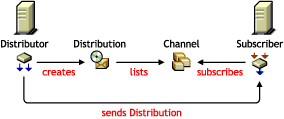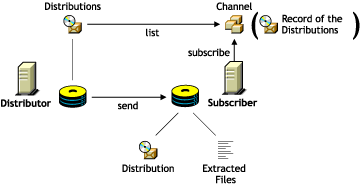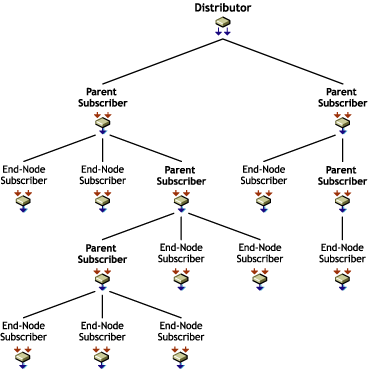3.2 Understanding Tiered Electronic Distribution
Review the following sections for an understanding of Tiered Electronic Distribution:
3.2.1 Distribution Management through Tiered Electronic Distribution
Tiered Electronic Distribution provides you with a way to manage your servers through the distribution of electronic data between servers. For example, application programs, collections of data files, software patches, and server policies.
When you install Policy and Distribution Services, the installation process creates Tiered Electronic Distribution and server policy objects in the eDirectory tree, copies software to the various servers, and sets up basic configurations for the Tiered Electronic Distribution and Server Policies components according to your installation selections.
The Tiered Electronic Distribution software can be hosted on NetWare®, Windows 2000, Windows 2003 Server, Linux, and Solaris servers.
Tiered Electronic Distribution uses a tiered distribution model that enables one server to indirectly service hundreds or even thousands of other servers. Tiered Electronic Distribution makes it easy to distribute files and policy packages by building them into compressed data files and hosting them in distribution channels for dissemination to the appropriate servers.
Tiered Electronic Distribution lets you schedule the distribution processes to take advantage of off-peak hours. It also sends notification of distribution status by sending e‑mail messages, logging events, displaying real-time messages, database reporting, and sending SNMP traps.
Server Management can efficiently process (send/receive/extract) Distributions that are large in size and contain a substantial number of files, such as an entire 4GB volume with greater than 50,000 file entries.
3.2.2 The Basic Distribution Process
The Tiered Electronic Distribution distribution process is based on the creation of Distributions (compressed file collections) that you use to move files and policies to your network servers. For more information, see Section 3.10.1, Understanding the Distribution Processes.
Following is a simplified distribution process. It is governed by schedules that you set for each of the Tiered Electronic Distribution objects involved with the Distribution file.
-
A Distributor creates a security certificate to provide distribution security.
-
A Distribution is built on the Distributor server’s file system according to the configuration you create in the Distribution object.
-
You associate the Distribution with a Channel.
-
You subscribe your target Subscriber servers to the Channel. This causes them to receive all of the Distributions contained in that Channel.
-
The certificate (from 1 above) is copied to Subscriber servers for Distribution security verification.
-
The Channel’s listed Distributions are sent from the Distributor to the Subscriber servers whose security certificates are valid.
-
The Subscriber extracts the files or policies from the compressed Distribution file and applies them according to the Distribution object’s configuration.
The schedules that you need to coordinate for sending Distributions are the Distributor’s Refresh schedule, the Distribution’s Build schedule, and the Channel’s Send schedule. However, we recommend that you leave the Distributor’s Refresh schedule set to the default of Never. For more information, see Determining the Distributor’s Refresh Schedule.
The schedules that you need to coordinate for receiving and extracting Distributions are the Channel’s Send schedule and the Subscriber’s Extract schedule.
3.2.3 Tiered Electronic Distribution’s eDirectory Objects
Tiered Electronic Distribution uses eDirectory objects and the related software for performing its distribution functions. The Distinguished Name (DN) of all Tiered Electronic Distribution objects includes the server name and component function of the host server.
The eDirectory schema extensions included in Tiered Electronic Distribution define the classes of eDirectory objects that are created in your eDirectory tree, including information that is required or optional at the time the object is created. Every object associated with Tiered Electronic Distribution in an eDirectory tree has a class defined for it in the tree’s schema.
You will extend the schema of your tree for the eDirectory objects listed in Table 3-7 when you install ZENworks 7 Server Management:
Table 3-7 Tiered Electronic Distribution eDirectory Objects
3.2.4 Relationships of the Tiered Electronic Distribution Objects
Figure 3-1 illustrates the relationships of the main Tiered Electronic Distribution objects:
Figure 3-1 The Distributor, Distribution, Channel, Subscriber, and External Subscriber Objects

Note the following from this illustration:
-
A Distributor creates a Distribution
-
The Distribution is listed in a Channel
-
A Subscriber subscribes to the Channel
-
The Subscriber receives the Distribution from the Distributor (possibly via a parent Subscriber)
3.2.5 Physical Network Connections
Distributor and Subscriber servers can be physically connected to the network in any configuration, including having some servers across WAN links. The following describes the possible physical interactions between Distributor and Subscriber servers:
-
A Subscriber server can be in the same geographic location as its Distributor server
-
A Subscriber server can be in a different geographic location from its Distributor server, such as across a WAN link
-
A Distributor server can service multiple Subscriber servers
-
A Subscriber server can be serviced by multiple Distributor servers
-
A Subscriber server can receive its Distribution files directly from a Distributor server
-
A Subscriber server can receive its Distribution files indirectly via another Subscriber server acting as a parent Subscriber
3.2.6 Distribution Flow Details
Figure 3-2 illustrates the physical flow of Tiered Electronic Distribution Distributions:
Figure 3-2 Tiered Electronic Distribution Flow

Note the following from the illustration:
-
A Distribution file is stored on the Distributor server’s hard drive
-
The Channel lists a Distribution (it does not hold a copy of the Distribution)
-
The Subscriber subscribes to a Channel to obtain all of the Distributions listed there
-
The Subscriber extracts the Distribution contents from the file’s compressed format and writes the content to the volume and directory specified in the Distribution’s configuration
IMPORTANT:When there are multiple versions of a File or Desktop Application Distribution, the Subscriber maintains copies of each of the versions, as is specified in the Distribution object’s properties. The default is to maintain 10 versions per Distribution type.
3.2.7 Tiered Electronic Distribution Processes
The following processes are used to perform Tiered Electronic Distribution functions:
Distributor Agent
The Distributor Agent is installed on each server where you select the Distributor option during installation.
This agent has the following functions:
-
Reads eDirectory for all Tiered Electronic Distribution configuration information (Distribution, Channel, and Subscriber) according to the Refresh schedule
-
Builds Distributions based on the information contained in the Distribution objects that are associated with the Distributor
-
Builds Distributions according to the Build schedule
-
Sends Distributions according to the Send schedule
-
Handles all notifications and events for the Subscriber
-
Sends DS configuration information found in Subscriber objects to each Subscriber as part of each Distribution
-
Logs Tiered Electronic Distribution information to the ted.log file for reporting purposes
Policy/Package Agent
The Policy/Package Agent is installed on each server where you selected the Policy and Distribution Server option during installation.
This agent has the following Tiered Electronic Distribution functions:
-
Reads and enforces policy information that has been extracted from Policy Package Distributions
For more information on policies, see Section 4.0, Server Policies.
-
Installs Server Software Packages that have been extracted from Software Package Distributions
For more information on software packages, see Section 5.0, Server Software Packages.
-
Logs policy and software package information to the zfs-startup.log file for reporting purposes
Tiered Electronic Distribution Software Running on the Subscriber Server
Tiered Electronic Distribution software is installed on each server where you selected the Policy and Distribution Server option during installation.
This software has the following functions:
-
Subscribes a Subscriber server to Channels for receiving Distributions
-
Receives and extracts the following Distribution types to the server’s file system according to the Extract schedule:
- Desktop Application 1
- File
- FTP
- HTTP
- MSI
- Policy Package
- RPM
- Software Package
1 The Desktop Application Distribution is only available when ZENworks Desktop Management is installed.
-
Installs the following extracted Distributions:
- Desktop Application
- MSI
- RPM
-
In the parent Subscriber role, receives a Distribution and forwards it on to other Subscriber servers
Distribution Processes Summary
Table 3-8 The Distribution Processes
3.2.8 The Tiered Distribution Model
The power of the tiered distribution model is that you can spread the workload for sending Distributions. This is particularly important to the Distributor servers. By sharing distribution duties with parent Subscribers, a Distributor server can have more resources available for reading eDirectory, building each of its Distributions, and logging information to the database.
Tiered distribution levels can be very deep, providing a very large number of Subscribers that any one Distributor can service—without doing so directly.
Figure 3-3 illustrates a distribution routing hierarchy containing a Distributor, several parent Subscribers, and many end-node Subscribers:
Figure 3-3 Distribution Route Hierarchy Showing Parent Subscribers and End-Node Subscribers

The Distributor can service hundreds of parent Subscribers directly, or service just a few first-tier parent Subscribers and let them do the bulk of the distribution work. In the above illustration, the Distributor only sends its Distribution to two parent Subscribers, yet nine end-node Subscribers receive the Distribution.
The parent Subscribers shown in this illustration can also receive the Distribution for extraction if they were also subscribed to the Distribution’s Channel. If all of the parent Subscribers in the above illustration were subscribed to receive the Distribution being sent to the end-node Subscribers, the Distributor services 14 total Subscriber servers while itself sending the Distribution only twice.
Each parent Subscriber can service hundreds of other parent Subscribers or end-node Subscribers (the intended recipients of the Distributions). The workload for passing on a Distribution by a parent Subscriber is minimal in compared to the workload for the Distributor to build the Distribution.
As you can see, the tiered distribution model allows you to minimize the distribution workload for your Distributor servers.
3.2.9 Tiered Electronic Distribution’s Key Components
In summary, the key components of Tiered Electronic Distribution include:
-
eDirectory schema extensions that include objects for Distributors, Distributions, Channels, Subscribers, and External Subscribers
-
ConsoleOne snap-ins and iManager plug-ins that provide creation, configuration, and management of Tiered Electronic Distribution
-
A Distributor Java process hosted on a NetWare, Windows 2000, Windows 2003 Server, Linux, or Solaris server for handling distribution of data packages to Subscribers
-
A Subscriber Java process hosted on a NetWare, Windows 2000, Windows 2003 Server, Linux, or Solaris server that subscribes to a Channel for its Distributions
-
A routing hierarchy for each Distributor that has a hierarchical list of Subscribers who can both receive Distributions for themselves and pass the Distributions on to other Subscribers
-
Parent Subscribers that pass Distributions on to other Subscribers
-
An External Subscriber object that allows distributing between trees or to servers that do not have eDirectory server objects
-
The Distributor Agent that controls the actual processes of building the Distribution files on the Distributor
-
Policy/Package Agent that extracts and enforces policy information from Policy Package Distributions, and extracts and installs the contents of software packages
-
Certificates that provide distribution security